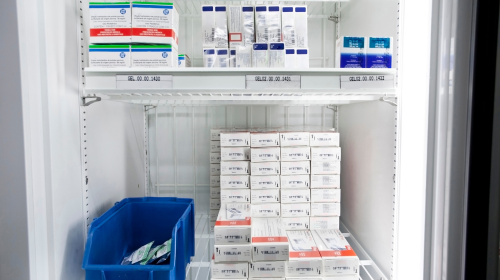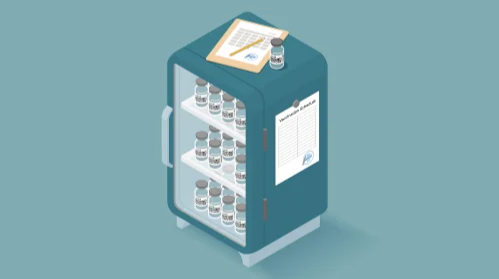Introduction
It’s no secret that vaccines are incredibly important, but they’re also sensitive to even the slightest environmental changes. Therefore, the success of a vaccination program rests on how vaccines are stored and handled.
That’s why the role of refrigeration in maintaining the quality of vaccines can’t be ignored. A vaccine storage refrigerator is the key to ensuring vaccines remain potent and effective while being stored and transported.
Read on to learn more about the importance of vaccine storage refrigerators and the best practices for vaccine storage.
Understanding Vaccine Storage Requirements
Vaccine storage requirements outline the necessary steps to ensure vaccines are safe and effective. The storage and handling of vaccines informs healthcare providers what temperature vaccines need to be kept at throughout all stages of manufacturing and delivery, implementing cold chain solutions. Cold chain processes are put in place to guarantee that vaccines are kept to specific conditions throughout manufacturing, distribution, and storage prior to administration.1 Storage requirements address what temperature the vaccine needs to be stored at, how long it can be out of the refrigerator, and what type of storage units are acceptable for storing vaccines.
The manufacturer of each vaccine sets specific storage requirements that are approved by the FDA prior to distribution. This information can be found on the physical packaging of the vaccines as well as in the package insert, which is found in the box and online on their website. The CDC publishes guidelines to advise health professionals of the best practices with regard to the storage and handling of immunoglobulins or vaccines.
Following storage requirements is imperative to maintaining the quality of vaccines and protecting communities against preventable diseases.2 If storage requirements are not met, the vaccine may lose its potency, failing to evoke an immune response in the recipient.1
Role of Refrigeration in Vaccine Storage
Vaccines require refrigeration in order to remain effective and ensure that they are safe to use. When vaccine temperatures become too warm or cold, the immunogenicity of the components can be altered, causing the vaccine to be ineffective.
High quality vaccine storage refrigerators and freezers are needed in order to store vaccines properly. Regular appliances found within a domestic home do not control temperature as evenly and precisely as those produced for medical use. The majority of vaccines need to be kept in a medical refrigerator at a temperature of 2°C to 8°C while frozen vaccines need to be kept in a medical freezer at -50°C to -15°C.3 Many pharmacies have vaccine refrigerators, however, vaccine freezers were not commonly found in pharmacies until the production of COVID-19 vaccines.
Best Practices for Refrigerated Vaccine Storage
Vaccine storage units may need to be adjusted overtime by a vaccine coordinator as advised by the CDC. Prior to adjusting, the vaccine coordinator should check to make sure the unit is not unplugged, the door was not left open, and the temperature monitoring device is not broken.1

The CDC recommends using a purpose-built or pharmaceutical grade unit for vaccine storage.1 Freezers should not be used in combination refrigerator/freezers due to cold spots and potential air circulation compromising refrigerated vaccines.2 In general, a vaccine refrigerator should have a digital display of the temperature, self-closing doors, barriers within the refrigerator to block off areas that do not meet temperature requirements, and audible and visual alarms when the temperature is out of range.4 These refrigerators may have a glass or solid door, though solid doors are preferred as they may be slightly more insulated.5
Vaccines must be kept in their original packaging to protect the contents from exposure to light.1 Additionally, removing loose vials or syringes from the packaging makes it difficult to separate different lot numbers and expiration dates. Many of the vials and labels of various vaccines look very similar. The original packaging of vaccines is more easily differentiated and clearly labeled, mitigating the risk of administration errors when choosing a vaccine from the refrigerator. It is also important to label shelves with the corresponding vaccine or diluent to avoid confusion and errors.1 Proper vaccine storage is necessary to ensure safe use and administration.
All personnel involved with vaccine storage and handling must complete necessary training including the CDC’s training module “You Call the Shots Vaccine Storage and Handling” as well as resources offered by their institution’s immunization program. These individuals will be responsible for recording the vaccine temperatures as well as the temperature of the location where the unit is stored. It is recommended to use a temperature monitoring device to track and record the temperature of the refrigerator at least every 30 minutes.1 The temperature of the room must be recorded as most units function optimally when located in a room that is between 20°C to 25°C.6
Common Challenges in Vaccine Storage and Handling
There are many obstacles that institutions run into when dealing with the proper storage and handling of vaccines. Any unit that is installed within an institution should have enough space to fit the largest inventory of vaccines that would be ordered at one time to avoid running out of storage space.1 If the storage unit malfunctions, the vaccine coordinator should refer to the standard operating procedure (SOP).1 The SOP will inform staff of the steps to take to prevent vaccine wastage. If the temperature of the refrigerator is out of range, report the temperature excursion to the vaccine coordinator.1 They will then evaluate the situation, using the backup temperature monitoring device, adjusting the temperature of the refrigerator, or proceeding to take the steps outlined in the SOP. In the case that there is vaccine wastage, follow the manufacturer and CDC guidelines on proper disposal. For example, the COVID-19 vaccine can be disposed of in non-hazardous or hazardous waste bins.
Innovative Technologies in Vaccine Storage Refrigeration
The future of vaccine storage refrigeration depends on the implementation of innovative technologies. One innovation more commonly being used is undercounter medical refrigerators. These refrigerators efficiently increase accessibility and space within medical laboratories, hospitals, pharmacies and other healthcare facilities. Under counter appliances will improve traffic flow, decrease the amount of time the refrigerator stays open, and be easier to maintain.
On the other hand, technology being developed at Princeton may eliminate the need for refrigerator storage units all together. The university has created a system for rapid-room temperature dehydration using ultra-fine droplet aerosols to convert vaccines into dry form. This technology would decrease the need for cold chain processes as well as lower costs associated with transportation and distribution. It will be fascinating to see how their revolutionary innovation is implemented in years to come.








